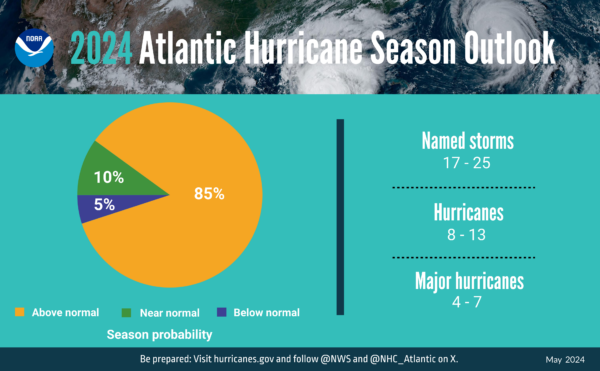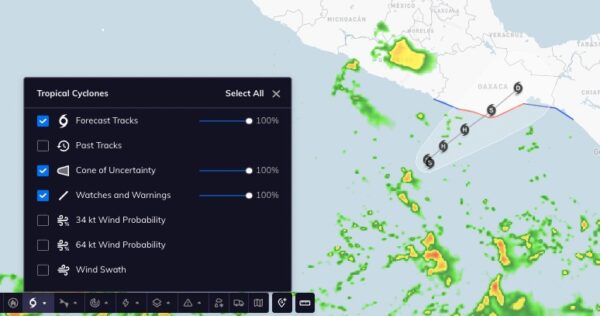TL;DR:
- NOAA predicts an aggressive 2024 hurricane season with potentially devastating impacts.
- Tomorrow.io collaborates with NOAA to enhance hurricane forecasting through innovative technologies.
- Climate change intensifies hurricanes, making accurate forecasting crucial for preparedness.
- Tomorrow.io’s ARENA Sensors project improves real-time storm data collection for NOAA.
- Tomorrow.io’s Resilience Platform now offers Global Cyclones Coverage for organizations to monitor and prepare for cyclones worldwide.
2024 Hurricane Season Warnings
The National Oceanic and Atmospheric Administration (NOAA) has issued an aggressive May 2024 prediction for the upcoming hurricane season, warning that it could be among the worst in decades.
Tropical cyclones, known as Hurricanes in the US, are some of the strongest and most impactful weather events we see on the Pacific and Atlantic coasts.
NOAA’s 2024 outlook for the Atlantic hurricane season, which spans from June 1 to November 30, “Predicts an 85% chance of an above-normal season, a 10% chance of a near-normal season and a 5% chance of a below-normal season.”

Image credit: NOAA
NOAA is forecasting 17 to 25 total named storms. Of those storms, 8 to 13 are predicted to be hurricanes, including 4 to 7 major hurricanes.
This forecast is the most aggressive NOAA has ever predicted ahead of hurricane season, underscoring the impact of increasingly volatile weather worldwide.
With hurricanes becoming more frequent and intense due to climate change, the need for advanced weather technology and innovative partnerships has never been more crucial.
Check out Expert Meteorologist, Micheal Huguet, break down this season’s forecast.
The Impact of Hurricanes
High winds, heavy rain, and storm surges can severely damage facilities, equipment, inventory, and infrastructure.
The impact of hurricanes has devastating economic and social consequences, causing billions of dollars in damage and displacing countless individuals.
Storms cause prolonged power outages and often force businesses to shut down for extended periods. Supply chain disruptions due to transportation network damage can lead to delays in delivering goods and services. Some storms are sever enough to require businesses to evacuate employees or implement safety protocols, further disrupting normal operations.
To put it in perspective, according to NOAA, there have been 363 billion-dollar weather disasters since 1980. Of those disasters, tropical cyclones (aka hurricanes) have caused the most damage, with over $1.3 trillion and an average of $22.8 billion per event.
Communities most vulnerable to hurricane damage often face the greatest challenges in recovery. Accurate and timely hurricane forecasting is essential for mitigating these impacts and enabling effective preparedness measures.
Addressing Climate Change in Hurricane Forecasting
Climate change is a significant factor in the increasing severity of hurricanes.
With warmer waters reported in the Atlantic over the past year, scientists have attributed storm outlooks in recent years to climate change “As global temperatures rise, cyclones are intensifying about three times faster than they did decades ago,” writes the Washington Post.
The partnership between NOAA and Tomorrow.io incorporates climate data into forecasting models, enabling more accurate hurricane intensity and frequency predictions.
Climate change data is crucial for long-term hurricane prediction and preparedness, as it allows for proactive measures to mitigate the impact of these storms.
NOAA and Tomorrow.io: An Innovative Collaboration
Tomorrow.io is making waves with new technologies, including a resilience platform powered by AI and their growing satellite constellation.
With a partnership between Tomorrow.io and NOAA, big changes could come to global weather forecasting.
According to Joe Bartlett, SVP of Business Development at Tomorrow.io, “Tomorrow.io has been involved in NOAA’s Earth Prediction Innovation Center (EPIC) for nearly four years.
We’re really focusing in on helping the agency develop its next-generation unified forecasting system, specifically to impact operational weather forecasting across short and long-term timescales.
Tomorrow.io’s role in EPIC is to extend the infrastructure needed for the broader weather community to contribute and collaborate in an open environment.”
By collaborating with NOAA, Tomorrow.io can support expanded global weather forecasting, which could improve hurricane forecasting accuracy.
That’s not all we’re working on with NOAA.
- AGTTI Project (Transfer of Technology for Innovation to Operations): This project focuses on transferring innovative research and technology into operational use, enhancing NOAA’s weather prediction capabilities.
- Arena Sensors Project: Tomorrow.io has been working on this project for about ten years. It uses sensors similar to those on satellites employed by hurricane hunters to improve weather data collection and forecasting accuracy.
- CREDA (Cooperative Research and Development Agreement): This memorandum of collaboration allows Tomorrow.io to work closely with NOAA scientists and colleagues in day-to-day tasks, facilitating ongoing interaction and collaboration.
This collaboration exemplifies the benefits of public-private partnerships in advancing weather forecasting and protecting communities.
How Tomorrow.io Supports Hurricane Forecasting
With Tomorrow.io’s ARENA Sensors project, Tomorrow.io has been working with NOAA to provide them with Tomorrow.io ARENA software-defined radars for hurricane forecasting.
These instruments are used onboard NOAA’s Hurricane Hunters to process real-time storm data.
Just last year, Clayton Bjorland, Senior Radar Scientist at Tomorrow.io, talked about his thrilling experience flying into the core of massive storms with NOAA’s Hurricane Hunter team.
We learned that NOAA typically collects data on the storm’s location, trajectory, and internal structure. On past flights, Clayton has worked with the NOAA NESDIS Star Team, which operates two instruments: KaIA and IWRAP.
According to Clayton, “These instruments both use Tomorrow.io ARENA software-defined radars, and there’s code that runs in real-time, processing the data. To make the retrievals for the wind speeds on IWRAP.”
KaAI and IWRAP complement the other instruments on the aircraft, providing measurements not made by the tail Doppler radar or SFMR. IWRAP provides a look at the vector field of wind factors going down to the ocean.
Both instruments provide several data points that weren’t previously available, helping to paint a complete picture of the storm and informing models and forecasts that predict sea state and storm surge.
Tomorrow.io’s cutting-edge technology enhances NOAA’s hurricane prediction systems, leveraging advanced data analytics and machine learning algorithms.
How Tomorrow.io is Improving Global Cyclone Forecasting
Global organizations need access to reliable, real-time tracking and forecasting as climate change fuels more intense and frequent cyclones.
Tomorrow.io recently announced updates to its Resilience Platform, including a Global Cyclones Coverage feature that provides critical forecasts and tracking of cyclones worldwide from their Resilience Platform dashboard.

Expanded global cyclone coverage via Tomorrow.io’s Resilience Platform
With Global Cyclones Coverage, organizations can feel the benefits of advanced technology.
- Monitor cyclone activity around the world in real-time
- Access detailed forecasts and projected impact areas
- Make informed decisions to protect assets and ensure continuity of operations
Tomorrow.io is committed to providing the tools and insights organizations need to build resilience in the face of climate change.
Their latest updates empower customers to make informed decisions, streamline communication, and proactively mitigate weather-related risks.
Looking Forward With Advanced Forecasting
Advancements in weather technology, such as Tomorrow.io’s satellite constellation and proprietary algorithms, can potentially transform hurricane forecasting.
These innovations enable earlier detection and more precise tracking of hurricanes by providing more granular and frequent data.
As the partnership between NOAA and Tomorrow.io continues to evolve, potential future developments and collaborations in the field could further enhance our ability to predict and prepare for these powerful storms.
When it comes to improving weather forecasting, private-public partnerships will take us far. NOAA and Tomorrow.io’s collaboration underscores the importance of advanced weather technology for hurricane forecasting.
By combining the expertise and resources of both organizations, this partnership has the potential to save lives and mitigate damage caused by hurricanes.
Through the power of science, technology, and collaboration, we can build a more resilient future in the face of these formidable storms.
















